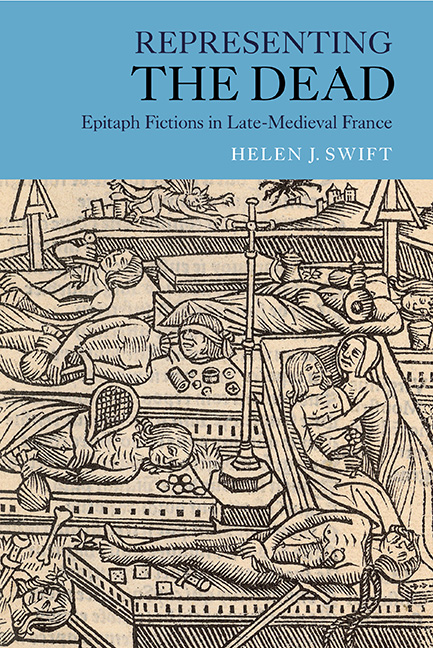Book contents
- Frontmatter
- Dedication
- Contents
- List of Illustrations
- Acknowledgements
- Note on Quotations
- List of Abbreviations
- Chronology of Epitaph Fictions
- Introduction: Representing the Dead
- 1 Framing Identity: ‘je suis’ and ‘cy gist’
- 2 Identity and/as Echo: the ‘Belle Dame’ querelle and Le Jardin de plaisance
- 3 Dying to be told: storytelling and exemplarity ‘selon le stile Jehan Bocace’
- 4 Placing the Dead: Cemeteries, Hospitals and Temples
- Afterword: Illustrating the dead
- Coda: Re-Member Me
- Appendix: Early Editions of the Jardin de plaisance et fleur de rethorique
- Bibliography
- Index
- Already Published
2 - Identity and/as Echo: the ‘Belle Dame’ querelle and Le Jardin de plaisance
Published online by Cambridge University Press: 17 June 2021
- Frontmatter
- Dedication
- Contents
- List of Illustrations
- Acknowledgements
- Note on Quotations
- List of Abbreviations
- Chronology of Epitaph Fictions
- Introduction: Representing the Dead
- 1 Framing Identity: ‘je suis’ and ‘cy gist’
- 2 Identity and/as Echo: the ‘Belle Dame’ querelle and Le Jardin de plaisance
- 3 Dying to be told: storytelling and exemplarity ‘selon le stile Jehan Bocace’
- 4 Placing the Dead: Cemeteries, Hospitals and Temples
- Afterword: Illustrating the dead
- Coda: Re-Member Me
- Appendix: Early Editions of the Jardin de plaisance et fleur de rethorique
- Bibliography
- Index
- Already Published
Summary
Mais toutesvois la court declaire
Qu’il n’y aura tumbe ne escripteau.
(Erreurs, vv. 1015–16)[However, the court declares that there will be no tombstone or epitaph.]
Chapter 1 encouraged us to approach posthumous identity interrogatively. Death itself as a question mark, and its implications for identity as a performative, echo-like entity, is particularly pertinent to the querelle de ‘La Belle Dame sans mercy’, the series of narrative poems responding to Alain Chartier's original debate between a Lady and her spurned Lover, which will form the backbone of this chapter. Neither protagonist is determined definitely and definitively to be dead until late on in the querelle. Epitaphic formulations in one of the very latest responses, Les Erreurs du jugement de la Belle Dame sans mercy, attest to both characters’ demise, but do so in a way that, far from closing down their story and wrapping up their identity, unravels the whole fabric of the querelle to lay bare the very nature of identity itself as performative, not based on a unitary, originary self. The first half of this chapter probes the nature of identity as a kind of constitutive echo. It charts associations in querelle responses between the Lady and Lover, on the one hand, and the legend of Echo and Narcissus, on the other. There is crossover in these associations such that both the Lady and the Lover are cast as each Ovidian character, which points to the porous boundaries of literary identity and how, in an intertextually intensive environment, it exists as interaction and slippage, a double movement of dispersal and assembly.
Such a working out of identity is not unique to a virtuosic literary phenomenon like the querelle. More generally, late-medieval French writers are demanding in their expectations of audiences’ intertextual competence and sophisticated reading practices. This is evident in the early print anthology of lyric and narrative verse Le Jardin de plaisance ([1501]), which underpins the second half of the chapter.
- Type
- Chapter
- Information
- Representing the DeadEpitaph Fictions in Late-Medieval France, pp. 91 - 145Publisher: Boydell & BrewerPrint publication year: 2016



